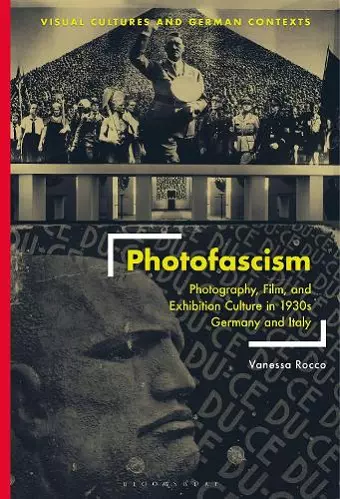Photofascism
Photography, Film, and Exhibition Culture in 1930s Germany and Italy
Format:Hardback
Publisher:Bloomsbury Publishing PLC
Published:24th Dec '20
Currently unavailable, and unfortunately no date known when it will be back

With stunning, previously unpublished installation shots, and a concise case study construction, this book alternates between exhibitions in Germany and Italy throughout the pivotal decade of the 1930s to demonstrate how fascist regimes relied on photographic spectacles to sell their perverse ideologies.
Photography and fascism in interwar Europe developed into a highly toxic and combustible formula. Particularly in concert with aggressive display techniques, the European fascists were utterly convinced of their ability to use the medium of photography to manufacture consent among their publics. Unfortunately, as we know in hindsight, they succeeded. Other dictatorial regimes in the 1930s harnessed this powerful combination of photography and exhibitions for their own odious purposes. But this book, for the first time, focuses on the particularly consequential dialectic between Germany and Italy in the early-to-mid 1930s, and within each of those countries vis-à-vis display culture. The 1930s provides a potent case study for every generation, and it is as urgent as ever in our global political environment to deeply understand the central role of visual imagery in what transpired. Photofascism demonstrates precisely how dictatorial regimes use photographic mass media, methodically and in combination with display, to persuade the public with often times highly destructive—even catastrophic—results.
A disturbing look into how German and Italian dictatorships of the 1930s utilized photography, film, and exhibitions—and how modern rallies aren’t much different. * Daily Beast, ‘Power of Photography’ *
This is, unfortunately, a time when it is urgent to analyze and pay attention to what this propaganda was and how its strategies operated effectively. I am grateful to art historian and photo historian Vanessa Rocco for doing a key slice of that work in her compelling, well-researched book. This rigorous historical work is timely: the rise of authoritarianism, the deflation of democracy, the mobilization of prejudice, while pushing measures unhealthy for the planet and for human well-being, demand consideration [and] Rocco does not hesitate to underline that the legacy of right-wing propaganda’s simultaneous messages of domination, belonging, and exclusion continues today. Rocco’s work also focuses on the mediums of photography, film, exhibition, and the use of photo and film in exhibitions. This international mass culture focus, I believe, will make it useful for teaching, as it invites comparisons between uses of international mass media for coercive propaganda then and now—and urges close looking at both. * Afterimage, Vol. 49, Number 4 *
Vanessa Rocco’s Photofascism is an outstanding achievement: a theoretically sophisticated and analytically compelling exposé of the way that the Italian and German dictatorships exploited exhibition culture in order to secure mass loyalty. Today, moreover, in light of fascism’s return, Rocco’s insights have assumed an uncanny contemporary relevance. * Richard Wolin, Distinguished Professor of History and Comparative Literature, The Graduate Center, The City University of New York, USA *
Photofascism provides a fascinating, timely, and theoretically rich analysis of the photographic exhibition as a potent piece of the twentieth-century fascist propaganda machine. Rocco has written a historically and geographically grounded study with compelling implications for contemporary society. * Dolores Flamiano, Professor, James Madison University School of Media Arts & Design, USA *
Rocco’s study represents a timely addition to the consolidated literature on photography as a means of seductive political persuasion and the monumental staging of power in interwar Europe. * Maria Antonella Pelizzari, Professor of Art History, Hunter College and The Graduate Center, The City University of New York, USA *
Rocco delineates a history of the fascist exhibition spaces of spectacle in the 1930s and emphasizes just how much the mediums of photography and film have been engaged to enhance false narratives. Her extensive research provides a history for the way that photo-based imagery has been - and still is - engineered to immerse us in spectacle until we can no longer see the ideological water in which we swim. * Lisa Jaye Young, ArtPulse *
ISBN: 9781501347061
Dimensions: unknown
Weight: 618g
210 pages